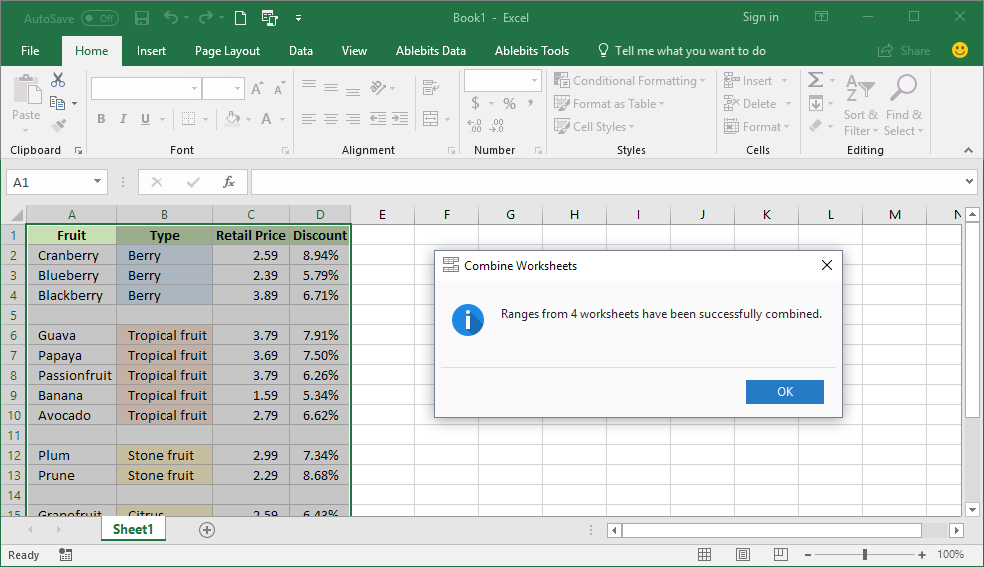5 Ways to Merge Excel Sheets into One

In today's interconnected business environment, efficiently managing and merging data from multiple sources is crucial. One common requirement is merging several Excel sheets into a single, cohesive document. This task can be daunting, especially when dealing with large datasets, but with the right tools and techniques, it can become straightforward. This blog post will explore five effective methods to merge Excel sheets into one, discussing both the simplest approaches for casual users and more technical solutions for power users.
Method 1: Using Copy and Paste


The most straightforward method to combine Excel sheets is by using the traditional copy and paste:
- Open the Excel workbook that contains the sheets you wish to merge.
- Select and copy the data from each sheet you want to merge.
- Paste this data into a new sheet or into an existing sheet with enough empty cells to accommodate the data.
❗ Note: This method is quick for small datasets but becomes less practical with large volumes of data, risking errors from manual operations.
Method 2: Consolidate Feature


Excel provides a feature called ‘Consolidate’ that allows you to combine data from multiple ranges:
- Go to the ‘Data’ tab in Excel.
- Select ‘Consolidate’ from the ‘Data Tools’ group.
- Choose the function you want to use (e.g., Sum, Count, Average).
- Select the ranges from the sheets you want to merge, ensuring you include headers.
Consolidate helps you summarize data and avoid manual errors by pulling data based on labels or positions.
Method 3: Using VBA Scripts


For those comfortable with Excel’s programming language, VBA scripts can automate the merging process:
- Open the VBA editor by pressing Alt + F11 or navigating through Developer tools.
- Insert a new module and write or copy-paste the VBA script that loops through all sheets or specific sheets to combine them.
Here is a basic VBA code to get you started:
| Sub MergeSheets() |
| Dim ws As Worksheet, sh As Worksheet |
| Dim lastRow As Long, lastColumn As Long |
| Set sh = ThisWorkbook.Sheets(1) |
| For Each ws In ThisWorkbook.Sheets |
| If ws.Name <> sh.Name Then |
| lastRow = sh.Cells(sh.Rows.Count, 1).End(xlUp).Row + 1 |
| lastColumn = ws.Cells(1, ws.Columns.Count).End(xlToLeft).Column |
| ws.Range(“A1”).Resize(lastRow, lastColumn).Copy sh.Range(“A” & lastRow) |
| End If |
| Next ws |
| End Sub |

💡 Note: VBA can be intimidating for beginners. Start with simple scripts and always back up your work before running scripts.
Method 4: Power Query (Get & Transform)


Power Query, available in recent versions of Excel, provides an advanced way to merge sheets:
- From the ‘Data’ tab, select ‘Get Data’ > ‘From File’ > ‘From Workbook’.
- Navigate to your Excel file, and choose the sheets you want to merge.
- Combine these tables using the ‘Append Queries’ option.
This tool is powerful for merging data from various sources and offers a GUI for data transformation and shaping.
Method 5: Using Third-Party Tools


Several third-party applications can simplify the merging process:
- Excel Compare by Formula Software, or Ablebits tools, offer functionalities to merge sheets with more control over the process.
- These tools often have drag-and-drop interfaces, making them user-friendly for those not familiar with Excel’s native features.
⚠️ Note: Third-party tools might come with additional costs and can introduce compatibility issues. Always review compatibility and licensing before purchase.
To recap, merging Excel sheets can be approached in several ways, each with its advantages:
- Manual Copy and Paste is simple but error-prone for large datasets.
- The Consolidate Feature offers a neat way to summarize data, though it requires data to have matching labels.
- VBA Scripts automate repetitive tasks but need programming knowledge.
- Power Query offers robust transformation capabilities for advanced users.
- Third-Party Tools provide user-friendly interfaces at a cost.
Choosing the right method depends on the size of your dataset, your comfort with Excel, the complexity of the merging task, and the frequency of such operations. Regardless of the method, the key to successful merging is ensuring data integrity, which means checking for duplicates, maintaining data formats, and preserving relationships within your data. By mastering these techniques, you can streamline your data management tasks, reduce manual errors, and enhance your overall productivity in Excel.
What is the simplest way to merge small datasets in Excel?

+
The simplest method for merging small datasets in Excel is using the Copy and Paste approach. It’s intuitive and requires no special tools, but be cautious of manual errors.
Can I merge Excel sheets automatically?

+
Yes, using VBA scripts or Excel’s Power Query feature, you can automate the process of merging sheets, making it efficient for repetitive tasks.
How do I handle different column structures when merging sheets?

+
When merging sheets with different structures, consider using Excel’s Consolidate feature with appropriate function or leverage Power Query’s ability to align columns from different sheets.
Are third-party tools always necessary?

+
No, many merging tasks can be accomplished with Excel’s built-in features. Third-party tools might be considered if you need more control, special merging rules, or when dealing with very large datasets.